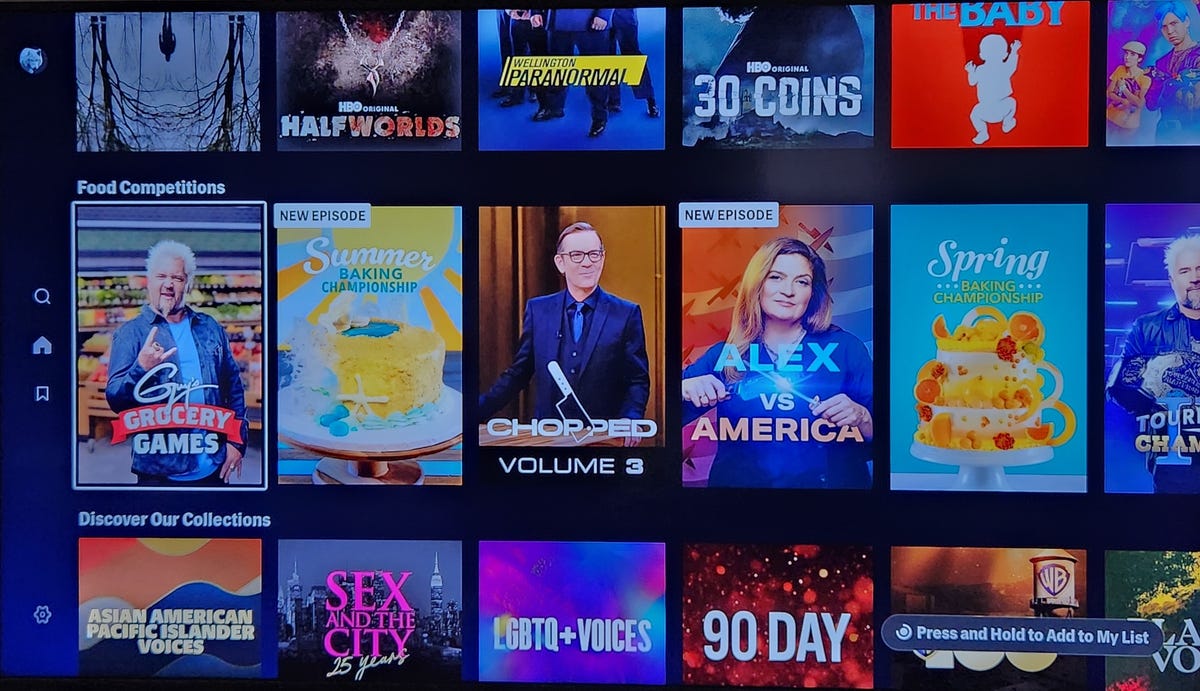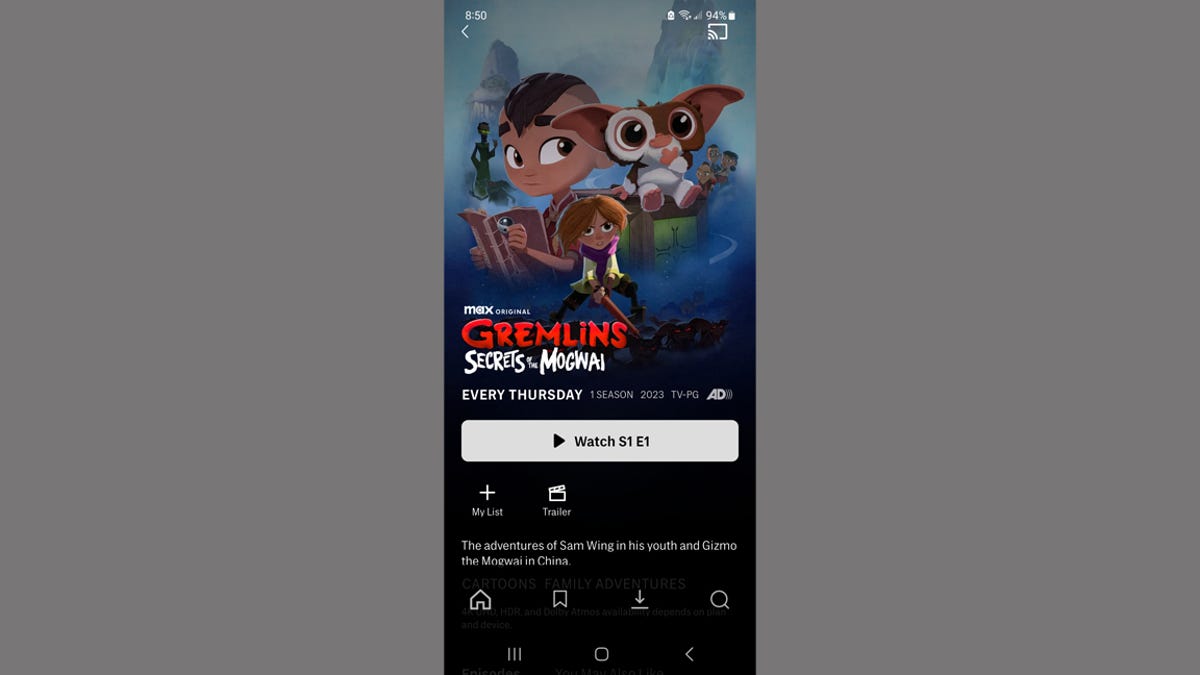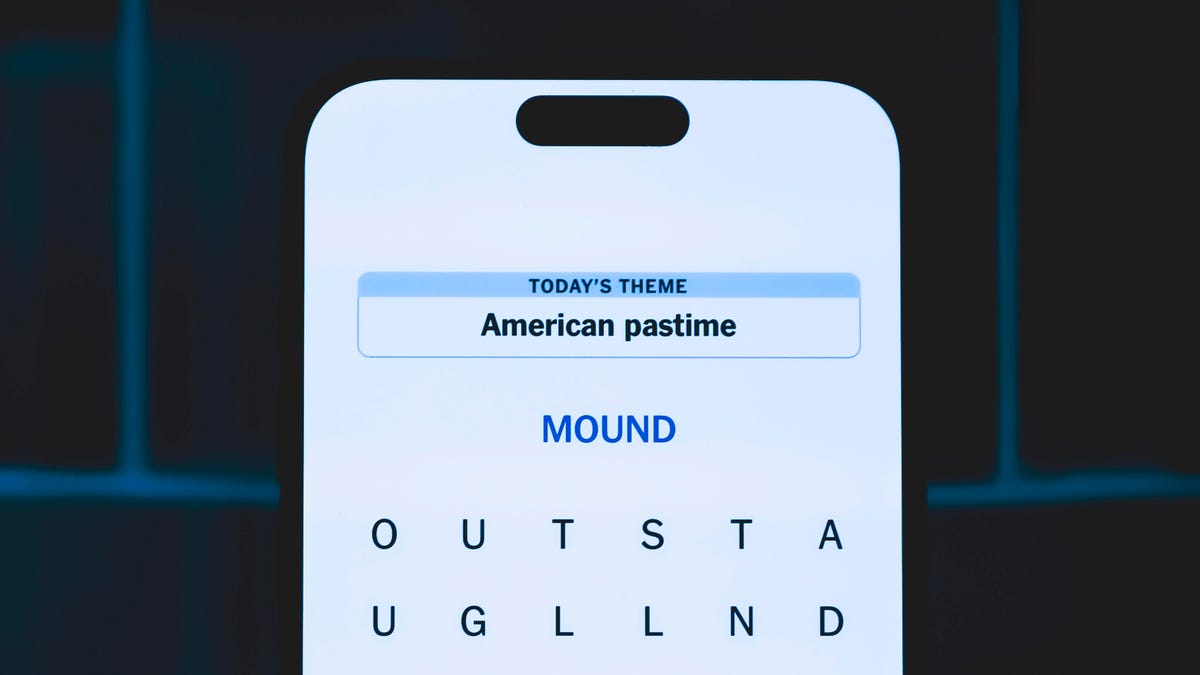Technologies
Max Streaming Service Review: A Wealth of Content, Everywhere at Once
MILF Manor and Batman now share the same address, and the neighborhood got more expensive. It might be time to move.

Like
- Huge library that covers any era and viewers of all ages
- Striking, eye-catching interface
- Larger selection of 4K titles
- Watch HBO shows as they air
- Kids’ content lineup and parental control features
Don’t like
- Glitchy user experience
- Missing episodes from popular TV shows
- High price, even with ads
Max is here. The refashioned streaming service replaces HBO Max and boasts more than 35,000 hours of content with a library twice as big as its predecessor. Blending Discovery Plus titles with the former HBO Max, the revamped service showcases the depth of the Warner Bros. catalog as befits a company that’s been in the entertainment business for 100 years.
HBO has long been considered prestige television with shows like The Sopranos, Game of Thrones and Succession. Warner Bros. Discovery chose to drop HBO from Max’s new name in favor of magnifying all of its brands and broadening its appeal to a larger audience — including kids. (It already has a top spot on our list of the best streaming services for kids.)
Merging all this content under one roof gives the platform a leg up on its biggest rivals: Netflix and Disney Plus. That said, Max is on the pricier side with a starting rate of $10 per month to watch with ads, going up to $20 if you want 4K and more streams.
If you already get access to Max for free, such as with an HBO cable subscription, you should definitely keep it. At the time of this writing, Max still has to work out some bugs with how the app functions to make streaming more seamless. But the breadth of the platform’s catalog and video quality makes it worth having, especially if you’re comfortable paying more money for a streaming service. You can always split the cost with someone outside your household and share your streams. And if you’re someone who only wants to stream Discovery Plus, it’s still available as a separate app.
Read more: Best Streaming Device for 2023
Streaming services compared
| Max | Disney Plus | Netflix | Prime Video | Hulu | |
|---|---|---|---|---|---|
| Monthly price | Starts at $10 | Starts at $8 | Starts at $7 | $9 (or included with $140/year Prime membership) | Starts at $8 |
| Ads | Yes | Yes | Yes | No | Yes |
| Top titles | Succession, House of the Dragon, Titans | The Simpsons, The Mandalorian, Bluey | Stranger Things, Queen Charlotte, Squid Game, Dahmer | Marvelous Mrs. Maisel, The Boys, Rings of Power | Handmaid’s Tale, The Bachelor, Bob’s Burgers |
| Mobile downloads available | Yes | Yes | Yes | Yes | Yes |
| 4K HDR available | Yes | Yes | Yes (on Premium plan) | Yes | Yes |
| Number of streams | 2 (4 for Ultimate) | 4 | 1 (2 for Standard, 4 on Premium) | 2 | 2 |
How much is Max?
Prices for Max subscriptions are the same as the old HBO Max: With ads, it’s $10 per month ($100 annually) and ad-free is $16 a month ($150 annually). But the new Ultimate ad-free plan is $20 monthly and will be the only subscription to offer 4K content and Dolby Atmos on select movies and shows. For now, features like 4K access and Dolby Vision will be accessible during the first six months of Max’s launch for legacy customers with the $16 ad-free plan.
Max subscription plans
| Ad-Lite | Ad-Free | Ultimate (ad-free) | |
|---|---|---|---|
| Monthly price | $10 | $16 | $20 |
| Number of screens you can watch at the same time | 2 | 2 | 4 |
| Number of offline downloads | 0 | 30 | 100 |
| HD available | Yes | Yes | Yes |
| 4K Ultra HD available | No | No | Yes |
Though most of the major streaming platforms have raised prices, Max remains among the most expensive services. Its pricing is comparable to Netflix for the ad-free experience, but at least you can still share your password without paying extra. We spent time testing all three subscription tiers and noted any differences between Max and the previous version of the app. Each plan offers something different.
Max’s stable of TV shows and movies is its power
Max has a hefty catalog that carries a range of films and TV series across multiple genres, and there is something for every age group in your household. The marriage between the HBO Max library and Discovery Plus serves up a selection of food, drama, comedy, animation, crime, superheroes, nature docs and lifestyle. In addition to HBO titles and Max originals, you’ll find DC, Studio Ghibli, CNN, Sesame Street, Looney Toons, Food Network, Magnolia Network, TLC, TCM, The CW and more — including the massive vault of Warner Bros. film and TV shows that spans a century. Only some things from Discovery Plus are on the platform though — namely the most popular content.
Warner Bros. Discovery says it will roll out «40 new titles and seasons every month» on the service. At launch, the service debuted new Max originals like Gremlins: Secrets of the Mogwai and SmartLess: On The Road, along with HBO originals such as Reality (starring Sydney Sweeney). The catalog will continue to expand in the coming months, including platform exclusives.

Gizmo has an original series on Max that’s perfect for the whole family.
The Justice League lives here with other DC properties, and Discovery’s stash of documentaries and reality TV shows is a click away. HBO favorites like Succession, The White Lotus, The Last of Us and House of the Dragon are available to stream as they air live on the cable network, with new episodes arriving each week. And you can still stream TCM classics such as Dirty Harry and National Lampoon’s Vacation on the platform.
Max’s offerings for kids are a highlight of the service, with plenty to stream from Elmo, Cartoon Network, Scooby Doo, Lego, DC, all versions of Teen Titans and a host of originals. That includes preschool content like Blippi, family movies and teen-friendly TV shows, animation and film franchises.
While exploring the content, I noticed missing episodes for some shows like Regular Show, which is a staple in my household. Steven Universe is seemingly intact, but other series like Amazing World of Gumball, Impractical Jokers and We Bare Bears are not. It’s unclear whether this is a temporary bug, a licensing matter or if Max is in the process of removing more content.
Read more: Max: The 34 Absolute Best TV Shows to Watch
Huge bonus: More 4K titles
On HBO Max, there were less than 40 movies and TV shows available to stream in 4K HDR. If you have the Ultimate plan and a device that supports 4K, you’ll be able to stream more than 1,000 titles, including Avatar: The Way of Water, House of the Dragon, Dune, The Wizard of Oz, Goodfellas, And Just Like That…, Euphoria and all the Harry Potter films. If you type «4K» in the search bar, 27 shows and movies pop up, but you should look for the format in the title’s description.
Warner Bros. Discovery said the 4K lineup might change, but you can find a list of what was available at launch by visiting this page. Be aware the company will continue to remove titles from the Max service as part of its cost-cutting strategy.
Read more: HBO Max Is Now Max: New Movies and TV Shows You Can Watch Right Now

Watch Avatar: The Way of Water in 4K on Max.
Early glitches
Before I dive into the experience of using Max, you should know my early testing was filled with glitches. Max arrived on May 23, days before Memorial Day weekend — prime time for streaming. I spent more than a week getting acquainted with Max, learning its strengths and flaws while comparing it to its previous incarnation and its competitors.
There were some hiccups. Just switching from the old purple HBO Max app on my Roku stick and Amazon Fire TV device to the new blue Max app was filled with frustration. And even after my week-long jaunt into Max, its performance was still less than smooth. Some of the glitches were minor e.g. a show host’s picture didn’t match the name in the description. Others, such as the TV app freezing and eventually kicking me out or some particularly wonky navigation, were more of an issue. For example, I found myself in a seemingly endless scroll of titles trying to reach the screen’s bottom, when suddenly the selector box got cut off, the app froze and my TV screen turned into a blue abyss.
But at least my profiles, watch list and Continue Watching rows all migrated without a hitch. I didn’t lose any playback progress for movies and shows that I stopped, either. And despite the bugs, the video quality on Max is top-notch. The phone app experience was considerably better, too. Max is actively working out any kinks on all platforms based on customer feedback, so the overall experience should get smoother. We’ll update this review with any progress in a month or two.

I kept losing my place when scrolling up and down rows of content.
User interface and navigation experience
For the most part, Max appears and operates similarly to HBO Max and other streamers like Hulu and Netflix. As promised, the rebranded service comes with some improvements and big changes to the user experience. The purple is gone (I miss it, and you may too), but even with the color palette switching to blue — like Paramount Plus, Disney Plus and Sling TV — the TV app is still crisp. The phone version seems darker but is still easy to follow. Among the added enhancements are an expanded set of profile avatars with more than 350 options, a default kid’s profile for new accounts and optimized personalization.

Navigation icons on Max’s phone app are at the bottom of a show’s title page.
Changes to the home screen, navigation and content organization are noticeable. The top rail has five tabs: Home, TV series, Movies, HBO and «New & Notable.» The prominent placement of the HBO tab is helpful as a direct path to finding all releases — new or old — from the network and a plus for those who only care a little about the Discovery Plus library.
On TVs, a new side panel has only three icons: Home, Search and My Stuff. The latter quickly took me to my Continue Watching section and watch list. On the phone app, this panel is located at the bottom and has a download icon if your plan includes them.
The top row on Max is Continue Watching (if you have one), followed by personal recommendations curated by the app and then My List (if you added titles). The home screen will become more personalized over time as the app learns your habits. In fact, all menu sections beyond the home page, such as Series and Movies, will become more personalized the more you use them.

The old hub layout on HBO Max (left) versus the new format on Max.
Scrolling down the home screen reveals Warner Bros. Discovery’s content brand hubs — all 18 of them — including HBO, TLC, HGTV, DC, Max Originals, Kids & Family or Ghibli. One obvious difference is the row of genre tiles is now located all the way at the bottom of the home screen. It’s inconvenient as you need to scroll past all the other rows, including Max’s curated collections, to get to them. You can use the app’s search to find them, but simply putting them higher up on the home page makes more sense to me.
As far as playback, I only experienced a few problems with Max. For example, while streaming one TV show episode, the video kept playing when I tried to rewind a scene, ignoring my command.
Recommendations need time to get to know you
Because Max is an upgrade — or enhanced update — of HBO Max, the streaming service starts from scratch when it comes to recommendations. Your history from HBO Max will not import to the new version, and with all the merged content from Discovery Plus, there’s more to sift through to watch — or skip. The algorithm needs time to learn who you are, and what you like, and will eventually catch up with your preferences, rotating in fresh additions.

Brand new rows of recommendations in Max.
The brand hubs will help you with the transition from HBO Max to Max, making it easier for customers to find content and fine-tune the recommendation machine. During testing, I noticed not all hubs are solely dedicated to their brands, so you’re likely to find some cross-hub suggestions. It goes deeper than that with related collections and links to other movies or TV series featuring a particular actor. For instance, you can select a Harry Potter cast member or other Warner-owned franchises and be whisked away to the land of Superman, Middle-Earth, The Matrix, James Bond and additional collections.
Using parental controls
I gave the default kid’s profile a spin to get a feel for the experience. It’s preconfigured with access to PG- and TV-PG-rated movies and shows. Parents can adjust the content ratings, and you’re prompted to do so the first time you click on the profile. You can only change the settings from a web browser, though.
Ratings range from little kids — which starts at TV-Y — up to teens, with the most mature options being TV-14 and PG-13. As long as you keep the profile set to Kids Mode, your child will only see age-appropriate content according to the ratings that you choose. If you toggle the kid-proof exit button, a four-digit PIN is required in order to exit the profile. The home screens look different depending on the age and content ratings, so you may want to create separate profiles if you have older kids and little ones in the family.
When I set my kid’s profile for teens, some of the titles that showed up on the home screen included Talladega Nights, Friends, The Big Bang Theory, 50 First Dates, Teen Titans Go! and the Harry Potter collection. Be aware that there’s a wide variety of content under the teen-rating umbrella if you’re a parent who wants to monitor what your child is watching.
Read more: 10 Things You Can Do to Save Money on Streaming
Streaming Max with ads vs. ad-free
On the ad-based plan, the ad load is virtually the same as before, with 3 to 4 minutes of commercials playing per hour of content. When I watched one 90-minute episode of 90 Day Fiancé, I encountered five commercial breaks of various lengths that lasted a total of 3 minutes, 15 seconds. By contrast, when I streamed Shazam 2 (which runs for 2 hours, 10 minutes), the total ad time was just under 2 minutes, including a 25-second preroll.
While using the kid’s profile, I watched one 24-minute episode of Full House with no ads, and it was the same for a short episode of Teen Titans Go. There were no commercials during films either in this profile. Competitor Disney Plus does include ads while streaming in a kid’s profile, though Max and Netflix avoid it. Still, if you can afford the extra $6 a month, go ad-free.
Downloads are only available on ad-free subscriptions, and speeds are fairly quick. It only took me about 35 seconds to download one episode of Barry on my phone, and a little over 3 minutes for The Batman — a movie that runs three hours. You have the option to select video quality for downloads, choosing from «good» for faster speeds, «better» for higher-quality video that uses more data or «best,» which downloads at a slower rate. It’s one of the areas that the Warner Bros. Discovery team worked to improve.
When I tested the app with the premium Ultimate subscription, I noticed the experience was the same as the $16 ad-free version. There’s a short promo reel featuring Max movies and shows that runs before some content, but not all. It played before Shazam!: Fury of the Gods, but not when I streamed an episode of Titans. So, for $4 more, we get two more simultaneous streams, all the 4K content and 100 downloads versus 30.
Technologies
Today’s NYT Strands Hints, Answers and Help for Jan. 9 #677
Here are hints and answers for the NYT Strands puzzle for Jan. 9, No. 677.

Looking for the most recent Strands answer? Click here for our daily Strands hints, as well as our daily answers and hints for The New York Times Mini Crossword, Wordle, Connections and Connections: Sports Edition puzzles.
Today’s NYT Strands puzzle is a fun topic — but one of the answers describes something I’ve never heard of before. Also, some of the answers are difficult to unscramble, so if you need hints and answers, read on.
I go into depth about the rules for Strands in this story.
If you’re looking for today’s Wordle, Connections and Mini Crossword answers, you can visit CNET’s NYT puzzle hints page.
Read more: NYT Connections Turns 1: These Are the 5 Toughest Puzzles So Far
Hint for today’s Strands puzzle
Today’s Strands theme is: For cubs fans.
If that doesn’t help you, here’s a clue: Like Gentle Ben.
Clue words to unlock in-game hints
Your goal is to find hidden words that fit the puzzle’s theme. If you’re stuck, find any words you can. Every time you find three words of four letters or more, Strands will reveal one of the theme words. These are the words I used to get those hints but any words of four or more letters that you find will work:
- LAIR, RAIL, CROP, LAID, BALD, DEAN, BROW, DIZZY
Answers for today’s Strands puzzle
These are the answers that tie into the theme. The goal of the puzzle is to find them all, including the spangram, a theme word that reaches from one side of the puzzle to the other. When you have all of them (I originally thought there were always eight but learned that the number can vary), every letter on the board will be used. Here are the nonspangram answers:
- BLACK, BROWN, GRIZZLY, PANDA, POLAR, SPECTACLED (That last one is the one I’ve never heard of! But it’s real!)
Today’s Strands spangram
Today’s Strands spangram is BEARSINMIND. To find it, start with the B that’s five rows to the right and three letters down, then wind up, over and down the whole far-right row.
Don’t miss any of our unbiased tech content and lab-based reviews. Add CNET as a preferred Google source.
Toughest Strands puzzles
Here are some of the Strands topics I’ve found to be the toughest.
#1: Dated slang. Maybe you didn’t even use this lingo when it was cool. Toughest word: PHAT.
#2: Thar she blows! I guess marine biologists might ace this one. Toughest word: BALEEN or RIGHT.
#3: Off the hook. Again, it helps to know a lot about sea creatures. Sorry, Charlie. Toughest word: BIGEYE or SKIPJACK.
Technologies
Today’s NYT Mini Crossword Answers for Friday, Jan. 9
Here are the answers for The New York Times Mini Crossword for Jan. 9.

Looking for the most recent Mini Crossword answer? Click here for today’s Mini Crossword hints, as well as our daily answers and hints for The New York Times Wordle, Strands, Connections and Connections: Sports Edition puzzles.
Need some help with today’s Mini Crossword? The Across clues were kind of tough today. Read on for all the answers. And if you could use some hints and guidance for daily solving, check out our Mini Crossword tips.
If you’re looking for today’s Wordle, Connections, Connections: Sports Edition and Strands answers, you can visit CNET’s NYT puzzle hints page.
Read more: Tips and Tricks for Solving The New York Times Mini Crossword
Let’s get to those Mini Crossword clues and answers.
Mini across clues and answers
1A clue: Question in a late-night text
Answer: YOUUP
6A clue: Plentiful
Answer: AMPLE
7A clue: Saint ___ and Nevis (Caribbean nation)
Answer: KITTS
8A clue: Baby-bringing bird
Answer: STORK
9A clue: Take care of the tab
Answer: PAY
Mini down clues and answers
1D clue: Himalayan herbivores
Answer: YAKS
2D clue: Fail to include
Answer: OMIT
3D clue: «High five!»
Answer: UPTOP
4D clue: The «U» of UV rays
Answer: ULTRA
5D clue: Annoying to deal with
Answer: PESKY
Don’t miss any of our unbiased tech content and lab-based reviews. Add CNET as a preferred Google source.
Technologies
I Got Up Close and Personal With Boston Dynamics’ New Atlas Robot
Before Atlas takes its first steps into the world of work later this year, I found myself face-to-face with CES 2026’s most talked-about robot on the show floor.

When I say that I went hands-on with the new Boston Dynamics Atlas robot, I mean that I actually held hands with it. This humanoid robot, which CNET just awarded the Best Robot of CES Award, is one of the most advanced in the world, and I couldn’t pass up the opportunity to get up close and personal with it.
This product version of the robot, which is set to be shipped to Hyundai factories imminently to start working, has been the talk of CES this year. The specific Atlas robot I encountered was a static model that wasn’t turned on or fully operational. Our interactions were, therefore, sadly one-sided. Still, I ran my hands over its soft-touch plastic shell and gently prodded at its finger joints, wondering how it would feel if they gripped me back.
People tend to have varying feelings about humanoid robots — understandable given that they are built to some degree in our image, while also usually being stronger than us, with «brains» that we don’t fully understand. Atlas definitely evokes contradictory emotions for me — even more so when I stood face-to-face with it.
I’m in awe of the engineering, a little fearful of its capabilities, hesitant about what it could mean for the future of humanity and charmed by its design and styling. The periwinkle blue iteration of Atlas that I met on the show floor at CES 2026 almost bears more resemblance to a Dyson product than it does the industrial robots that defined Boston Dynamics’ early days, when it was best known for its work with DARPA.
«There’s a lot of really specific things about this robot that probably look a little weird,» said Zachary Jackowski, Boston Dynamics VP and general manager of Atlas. He pointed to the legs, which he described as «like nothing anyone else was doing.»
Atlas’ thighs are narrow set and in line with the torso, while the calves are wider set, attached to their upper counterparts with a circular joint. This robot is, in fact, all subtle curves and soft lines. There are no harsh edges or stark angles.
During a year when CES has been flooded with humanoid robots, Atlas definitely does stand out due to its design. It appears both less classically human and less industrial than some of its peers, while also lacking the often intimidating, featureless faces they tend to exhibit. Instead, it has two low-set cameras resembling eyes placed where you’d usually expect a mouth to be. Its face is a perfect flat circle, defined by an LED halo that gives it a somewhat Pixar lamp effect.
I asked Jackowski why Boston Dynamics decided to skew so relatively unhuman with this version of its humanoid. «Well, it’s not a human,» he said. «It projects the wrong first impression about a robot to have it pretend to be something that it’s not.»
Particularly in the early days of humanoids, he added, robots won’t have anything like human-like intelligence. People should look at it and see it for what it is — a tool for performing tasks safely and efficiently.
In fact, most of the design decisions were made to keep Atlas as simple, scalable and safe as possible, Jackowski said. I remark that there’s some irony in thinking of a humanoid robot as simple, given the complexity of the technology and development process to bring Atlas to life.
The key to making it simple, Jackowski said, is having a strong enough grasp of the technology to «accomplish the complex thing of building a humanoid robot,» but then being able to take it apart and understand that you can use fewer computers and actuators in it while achieving the same results.
And it’s essential to Boston Dynamics that Atlas is perceived as simple. After all, it’s a general-purpose humanoid, which might eventually be sent far and wide to fulfil all manner of roles. Jackowski calls it the «ultimate generalist.»
Simplicity aside, there are aspects of Atlas that Jackowski believes set it apart from other humanoids at the show. «The repairability of this robot is crazy good,» he said. «The runtime is crazy good. The strength is unlike anything.»
From working in Hyundai’s manufacturing plants, Atlas’s job trajectory is to eventually graduate to many of the same industrial environments where Boston Dynamics’ Spot robot works, before moving to bussing tables in the service industry and eventually into the home. The robot will evolve between now and then, Jackowski said. However, this could be an early glimpse of the type of humanoid that will eventually be our housemate.
That’s some way away, though, which is probably for the best. As I gaze up at Atlas, which I’d guess is around the same height as my husband, my feeling is that, however impressive Atlas is, I’m still not ready for it to move in.
-

 Technologies3 года ago
Technologies3 года agoTech Companies Need to Be Held Accountable for Security, Experts Say
-

 Technologies3 года ago
Technologies3 года agoBest Handheld Game Console in 2023
-

 Technologies3 года ago
Technologies3 года agoTighten Up Your VR Game With the Best Head Straps for Quest 2
-

 Technologies4 года ago
Technologies4 года agoBlack Friday 2021: The best deals on TVs, headphones, kitchenware, and more
-

 Technologies4 года ago
Technologies4 года agoGoogle to require vaccinations as Silicon Valley rethinks return-to-office policies
-

 Technologies4 года ago
Technologies4 года agoVerum, Wickr and Threema: next generation secured messengers
-

 Technologies4 года ago
Technologies4 года agoOlivia Harlan Dekker for Verum Messenger
-

 Technologies4 года ago
Technologies4 года agoiPhone 13 event: How to watch Apple’s big announcement tomorrow
